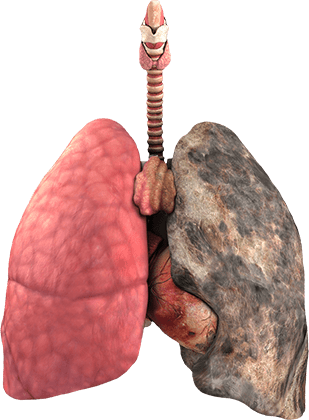DNA test for genetic predisposition to lung cancer
Lung cancer is the most common malignant tumor, and the leading cause of death among cancer patients. About three-quarters of first diagnoses of lung cancer are stage III-IV tumors.
by e-mail (anytime):
 EN | USD
EN | USD
by e-mail (anytime):
Lung cancer is the most common malignant tumor, and the leading cause of death among cancer patients. About three-quarters of first diagnoses of lung cancer are stage III-IV tumors.


Lung cancer develops in the epithelial cells lining the bronchi and bronchioles. The tumorous process is deceptive in that the disease progresses without symptoms for a long period. By the time the patient begins to worry about the early symptoms, the oncological process has usually already spread beyond the original site and formed metastases.
The leading cause of lung cancer is the inhalation of tobacco smoke, which contains dozens of chemical agents that trigger the malignant reproduction of the body's cells. The proportion of lung cancer patients who are smokers, or who were long-time smokers, is variously put at between 80 and 90%. Studies show that, from the moment a person gives up smoking, the risk of developing this dangerous disease falls gradually over time, although it always remains higher than in those who have never smoked.
So-called passive smoking is another significant risk factor, but with a substantially weaker carcinogenic effect than active smoking.
The second factor proven to increase the risk of lung cancer is radon. The atmospheric concentration of radon depends on the geology of the area and the weather conditions. It has been shown that living in an area with a high atmospheric radon content increases the risk of lung cancer.
Industrial air pollution is the third most significant risk factor. Particularly significant are the occupational hazards involved in regular inhalation of dust containing asbestos, chromium, cadmium, arsenic or nitro-enamel.
Despite a multitude of studies and the comprehensive data obtained, it is still not known precisely why, for example, many hardened smokers do not get lung cancer, while this dangerous disease is unexpectedly found in some people who have always followed a healthy lifestyle. To explain this paradox, scientists point to hereditary predisposition, which manifests itself in the characteristics of the repair processes, and to the genetically determined susceptibility of the bronchial epithelium to harmful external factors.
The configuration of an individual's genes is fixed at the moment of conception. This is what determines the person's set of structural and functional characteristics – his so-called biological constitution. Unfortunately, any biological constitution contains a certain set of "weak links" that may in future be the decisive factor in the development of diseases.
constitution. Unfortunately, any biological constitution contains a certain set of "weak links" that may in future be the decisive factor in the development of diseases.
Scientists hypothesize that, in the case of lung cancer, the genetically determined "weak link" is heightened repair activity in the epithelial cells of the bronchi and bronchioles. The lungs of people with such cells recover more quickly from microtrauma. Under the prolonged impact of harmful factors, however, this property of the pulmonary epithelium can trigger uncontrolled growth in the number of mutated cells, forming a malignant tumor.
None of the symptoms of lung cancer are specific, i.e. characteristic only or predominantly of that illness.
People usually go to the doctor for one of the following reasons:
coughing – usually a dry, hacking cough;
shortness of breath;
a sensation of breathing difficulty;
bloody phlegm;
weakness, lack of stamina;
bad breath;
unexplained weight loss;
prolonged subfebrile fever;
rib pain.
Any of the above symptoms should be a reason to see a specialist, but there is no need to panic: coughing and shortness of breath can be a sign of lingering bronchitis; bad breath can be a symptom of deep caries. Even coughing up blood, which looks very alarming, is far from always an indication of tumor disintegration: for example, it may result from increased vascular wall permeability due to a viral infection.
During the initial growth period of the tumor site, the patient normally experiences no discomfort, but the respiratory function of the lung is gradually impaired. Even a small tumor blocks the air flow in the affected region of the lung, and if immunity is temporarily lowered (by hypothermia or acute respiratory disease, for example), it hinders the natural cleansing of the alveoli and encourages the development of inflammation. Pneumonia, particularly if it recurs in the same place in a short time, can thus indicate the presence of a neoplasm in the lung.
In the classification of lung cancer, two main types of the disease are distinguished, with significantly different prognoses.
A number from 0 to 4 is placed after each letter, with 0 meaning that the sign is absent, and 4 indicating its maximum extent. For example, T1N0M0 is a tumor up to 3 cm in diameter with no spread to lymph nodes and no metastases. If lymph nodes are involved in the tumor process, and if metastatic sites are found, the prognosis becomes significantly worse.
Every day, hundreds of thousands of people all round the world spend hundreds of millions of dollars on cancer treatment!
Don't wait for cancer to come to you! Have a DNA test for genetic predisposition to lung cancer – protect yourself and your family.

The following methods are used to diagnose lung cancer:
X-ray examination was for many years considered the main diagnostic tool for lung cancer, but it is clearly insufficiently informative where this disease is concerned. Because the tumor site is of similar density to healthy tissue, it shows up poorly in x-rays. If the tumor is masked by a rib, it becomes ever harder to see in a photograph.
The most informative methods of early diagnosis of lung cancer are PET/CT and MSCT. They achieve accuracy of 90% or more, and can detect tumors as small as 3-5 mm. The problem with using these methods is their high cost, which means they are not used for mass screening of early-stage lung cancer.
Bronchoscopy is another effective means of detecting the disease, but it is used only to determine the nature of a previously discovered site of lung tissue compaction. Bronchoscopy is an endoscopic method: under local (or in some cases general) anesthetic, a flexible bronchoscope is introduced through the mouth or nose and used to examine the internal surface of the trachea and large bronchi. If a neoplasm is observed, special manipulators are introduced through the bronchoscope and used to take a biopsy — a small piece of pathological tissue is cut out for later examination under the microscope in order to determine the tumor type.
Ideally, the treatment of any malignant tumor should be radical, meaning the complete removal of all cancer cells from the body. With lung cancer, this can only be achieved at the earliest stages, when the tumor is localized and its cells have not reached the lymph nodes or any distant organs or tissues.
During the operation, a thoracotomy allows the removal of the tumor together with an area of healthy tissue; this is highly important for full treatment and for prevention of metastasis. The procedure generally involves removal either of part of the lung (lobectomy) or of the entire lung (pneumonectomy).
If necessary, to improve the patient's quality of life, the operation will conclude with reconstructive plastic intervention.
The following groups of preparations are used to treat lung cancer:
chemotherapy agents:
these suppress the cell division processes, thereby curbing the growth of the tumor;
immunotherapy agents:
these act on the cancer cells indirectly, via the immune mechanisms;
Targeted drugs:
these block the proteins responsible for tumor growth.
The advantage of modern immunotherapy and targeted therapy over chemotherapy is that the treatment is considerably more bearable: the side effects generally present no risk to the patient's life and are relatively infrequent. The main disadvantage of this treatment is the cost of the agents.
Radiotherapy works by damaging the genetic structure of the tumor cells, thus preventing them from dividing. The following types of radiotherapy are used to treat lung cancer:
External-beam radiotherapy:
the tumor receives a dose of radiation from an external source, with modern equipment allowing the effect to be targeted with maximum precision.
Contact radiotherapy (brachytherapy):
the radiation source is tiny and is introduced directly into the tumor site.
Depending on the disease type and the patient's condition, lung cancer treatment may involve a combination of the above-mentioned methods.
When neglected lung cancer is detected, treatment involved palliative care designed to improve the patient's well-being. Narcotic analgesics, oxygen or chemotherapy may be prescribed, depending on the particular clinical situation. Palliative surgical intervention is carried out in many cases, e.g. to relieve compression of the main bronchus.
The key to preventing lung cancer is a healthy lifestyle, no smoking, and an informed choice of domicile with as low a level of atmospheric carcinogens as possible. Another, no less important, cancer protection factor is a regular medical check-up, which will enable detection of the disease in the earliest stages and give the option of radical treatment.
Unfortunately, standard x-ray examination gives insufficient information for early diagnosis of lung cancer, and the tumor markers that have lately been so popular are not specific enough and are only a supplementary diagnostic tool. This makes it important to know in advance how high a probability you have of developing this feared disease.
The only reliable way to determine your genetic predisposition to cancer is to take a DNA test. The treating physician will use the data obtained to draw up an individual screening plan taking account of the personal genetic characteristics that are specific to you.
Look after your health: begin effective prevention of lung cancer as soon as possible!
